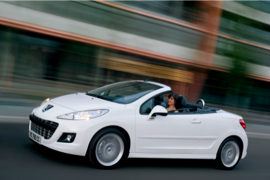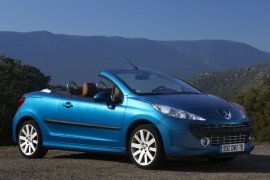PEUGEOT 207 CC Models/Series Timeline, Specifications & Photos
First production year: 2007
Engines: Diesel, Gasoline
Body style: Convertible (spider/spyder, cabrio/cabriolet, drop/open/soft top)
Peugeot replaced the 206 range in 2006 with the 207 lineup, but it introduced the open-top version for it only in 2009.
Even though it was already developed, the 207 CC project was frozen until the global financial crisis was closing to its end, the customers could start buying leisure vehicles. Otherwise, the carmaker could face the risk of unveiling a car that buyers did not demand on the market. Thus, the 207 CC was postponed three years before its power-operated hardtop was revealed in front of the customers.
At the front, the 207 featured Peugeot's new design language. It sported big, swept-back headlights extended from the front fascia to a few inches away from the A-pillars. The raked windshield was the only body element above the beltline when the roof was retracted. Is sculptured side panels were different than those installed on the regular 207 hatchback.
The cabin featured four seats, but the rear ones were large enough for a shopping bag with two pairs of shoes inside it. Due to the power-operated roof, the carmaker had to push the rear seats forward to accommodate the retracting mechanism. For the front occupants, Peugeot installed sporty-looking bucket seats with side bolstering and a set of aluminum pedals for the driver.
Under the hood, Peugeot installed a choice of three engines paired with a five or six-speed manual gearbox or a four-speed automatic for the 1.6-liter naturally aspirated unit.
Peugeot was the first car-manufacturer that offered an affordable retractable hard-top vehicle on the market with the 206 CC. In 2007, the 207 has received a CC-version.
The CC means Coupe-Cabriolet. When Peugeot launched the 206 CC in 2000. The concept of a retractable hardtop was not new. It was present also in 1935 Peugeot 402 Eclipse. With the hardtop on, the car was just like any other coupe vehicle. It featured far better acoustic and thermal comfort than a soft-top vehicle. After the big success of the small 206 CC, that concept was extended to the 307 CC (in the compact segment) and, in 2007, on the 207 CC, which was the successor of the 206 CC.
The 207 CC featured the front styling of the 207 hatchback range, with angular and long headlights that were inspired by the feline world. A raked and thick A-pillar supported the windshield and also acted as a security arch in the event of a roll-over accident. The sloped, rear trunk-lid was still usable even with the roof down.
Inside, the 207 offered four seats. When compared with the 206 CC, the rear seats were usable due to its increased wheelbase and interior design. Like its predecessor, the 2007 Peugeot 207 could have been opened and closed only with the vehicle stopped.
Under the hood, the 207 CC offered a range of diesel and gasoline units mated to a standard 5-speed manual transmission. An option for automatic was available for selected engines.

